Suez Canal
 The
day started at a leisurely pace. A cool wind blew down on us as we lay at anchor
just behind another freighter. I could see part of the town beneath the
sandstone cliffs. I wandered up to the bridge for a yarn with the First Officer
and to take photos of the chart. Then down to B deck for scrambled eggs and
crispy bacon and a relaxed chat around the breakfast table with my fellow
passengers. Climbing back up the stairs we were preceded by portly Egyptian
pilot who was making laborious weather of it. He was aboard to guide us from the
anchorage to our place in the convoy queue and then through the Suez Canal. We
felt the shuddering of the anchor being hauled aboard at the same time as we
watched the neighbouring ship Hanjin stirring up yellow mud as it
manoeuvred in the shallow water behind us. Every day just one convoy passes
through the canal in each direction while other ships pass through in stages.
I'm not sure of the exact routine and I didn't want to bother the officers with
what they probably think are a whole lot of silly questions. The canal is not
used at night. The Captain did say that it costs something like one-hundred and
ninety-thousand dollars for a ship our size, the cost carefully calculated to
make it just a little more economical to use the canal that to go the long way
around the bottom of Africa. It's a nice little earner for Egypt no doubt.
The
day started at a leisurely pace. A cool wind blew down on us as we lay at anchor
just behind another freighter. I could see part of the town beneath the
sandstone cliffs. I wandered up to the bridge for a yarn with the First Officer
and to take photos of the chart. Then down to B deck for scrambled eggs and
crispy bacon and a relaxed chat around the breakfast table with my fellow
passengers. Climbing back up the stairs we were preceded by portly Egyptian
pilot who was making laborious weather of it. He was aboard to guide us from the
anchorage to our place in the convoy queue and then through the Suez Canal. We
felt the shuddering of the anchor being hauled aboard at the same time as we
watched the neighbouring ship Hanjin stirring up yellow mud as it
manoeuvred in the shallow water behind us. Every day just one convoy passes
through the canal in each direction while other ships pass through in stages.
I'm not sure of the exact routine and I didn't want to bother the officers with
what they probably think are a whole lot of silly questions. The canal is not
used at night. The Captain did say that it costs something like one-hundred and
ninety-thousand dollars for a ship our size, the cost carefully calculated to
make it just a little more economical to use the canal that to go the long way
around the bottom of Africa. It's a nice little earner for Egypt no doubt.
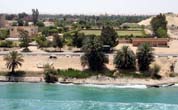 I
spent the entire day out on E deck walking from one side of the ship to the
other, afraid to miss so much as a grain of sand. You will be able to see that I
also took some photos from the wheelhouse roof but it was too exposed for me to
stay up there for long and also I preferred the lower elevation for photography.
By evening I was absolutely knackered but so grateful for the experience.
I
spent the entire day out on E deck walking from one side of the ship to the
other, afraid to miss so much as a grain of sand. You will be able to see that I
also took some photos from the wheelhouse roof but it was too exposed for me to
stay up there for long and also I preferred the lower elevation for photography.
By evening I was absolutely knackered but so grateful for the experience.
Photography was very difficult because of haze, particularly on the Sinai side
where the desert sand blended with the sky. Although at times I could see five
or so vessels in front or behind, even the nearest would be out of focus and the
most distant just a smudge of grey, which was a pity because I was unable to
fully capture the essence of being part of a convoy. We moved at a sedate pace,
hardly causing a ripple. The occasional pilot boat or tug created a bigger wake
than we did. You will notice that the banks are lined with blocks of stone to
prevent erosion from the wash and in affluent locations the stone work is
carried right up to the foundations of buildings. The entire canal is dredged
out of sand and sandstone through very low country. Some stretches are straight
and others follow a winding course. In the middle is a natural lake where, with
the aid of dredging, ships are able to pass.

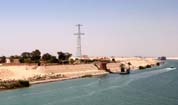
 There
is a double passing canal in one place where you see the ships in it as if they
are stranded in the sand. They were difficult to photo against the light. I got
as many of other ships as I could for the interest of the crew who want copies.
There are several canal control stations that are designated on the chart as SCA
Signal Towers that have electronic display screens and no doubt radio contact
between stations and with pilots on the ships. All the way through there are
numbered iron bollards set in concrete to which a ship could be moored hard to
the side in the case of breakdown. The ships waiting in the twin channel were
tied to such bollards.
There
is a double passing canal in one place where you see the ships in it as if they
are stranded in the sand. They were difficult to photo against the light. I got
as many of other ships as I could for the interest of the crew who want copies.
There are several canal control stations that are designated on the chart as SCA
Signal Towers that have electronic display screens and no doubt radio contact
between stations and with pilots on the ships. All the way through there are
numbered iron bollards set in concrete to which a ship could be moored hard to
the side in the case of breakdown. The ships waiting in the twin channel were
tied to such bollards.

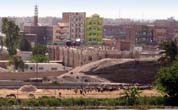
 Nearly
all the way through as you look left (to port) you see a densely populated Egypt
with endless buildings, hundreds of mosques and minarets, palms and trees,
fertile fields of corn and other crops that I couldn't identify at the distance,
irrigated I suppose from the Nile. For quite a distance there was a fresh-water
canal running parallel to the Suez Canal and even where its water can't be seen,
its presence is marked by papyrus growing along its banks which you will note in
the foreground of a few photos. To the north it was interesting to see how urban
development tailed out as it does in all developing urban environments: going
from the equivalent of the leafy suburb, through blocky high-rise housing and
finally reducing to single-storey places devoid of trees and in this case
tapering right off into sand.
Nearly
all the way through as you look left (to port) you see a densely populated Egypt
with endless buildings, hundreds of mosques and minarets, palms and trees,
fertile fields of corn and other crops that I couldn't identify at the distance,
irrigated I suppose from the Nile. For quite a distance there was a fresh-water
canal running parallel to the Suez Canal and even where its water can't be seen,
its presence is marked by papyrus growing along its banks which you will note in
the foreground of a few photos. To the north it was interesting to see how urban
development tailed out as it does in all developing urban environments: going
from the equivalent of the leafy suburb, through blocky high-rise housing and
finally reducing to single-storey places devoid of trees and in this case
tapering right off into sand.
In stark contrast the right-hand
side (to starboard) is unrelenting desert. In places there are distant strips of
dark green indicating palms along narrow valleys but in general it is just sand
and more sand.
The first nine shots with
buildings are all at the beginning of the canal and the city of Suez. There is a
ship sitting in a dry dock behind which are some passenger ships. While we were
in Jeddah a similar one came in and I wonder if their main purpose is to
transport pilgrims on their way to Mecca. There was no obvious boundary to Suez
and although the land bordering the canal gradually became more rural, the city
dwellings seemed to continue indefinitely in the background.
 Most
startling was the presence of military barracks, guard houses, checkpoints, road
blocks and solitary soldiers stationed in tiny concrete observation posts or
positioned on knolls of sand with as little as four sticks and a bit of cloth
for a sun shelter. All had flags. Even the lone soldier armed with a gun stood
by an orange flag fluttering in the wind which may as well have said, "Here I
stand. Shoot me!" Perhaps his function was to provide a warning shot? The
exposure suffered must be considerable. You can see man tracks worn on some of
these hillocks from years of use and often the banks are inscribed with Egyptian
lettering formed by the arrangement of stones. Each encampment of any size had
its own mosque and stones were used to affect significant patterns where in
other environments you could perhaps expect flower gardens.
Most
startling was the presence of military barracks, guard houses, checkpoints, road
blocks and solitary soldiers stationed in tiny concrete observation posts or
positioned on knolls of sand with as little as four sticks and a bit of cloth
for a sun shelter. All had flags. Even the lone soldier armed with a gun stood
by an orange flag fluttering in the wind which may as well have said, "Here I
stand. Shoot me!" Perhaps his function was to provide a warning shot? The
exposure suffered must be considerable. You can see man tracks worn on some of
these hillocks from years of use and often the banks are inscribed with Egyptian
lettering formed by the arrangement of stones. Each encampment of any size had
its own mosque and stones were used to affect significant patterns where in
other environments you could perhaps expect flower gardens.
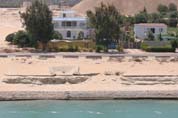 There
were few armoured vehicles in evidence, no big guns or tanks and only a couple
of structures that may have been missile emplacements. No doubt there are plenty
of armaments hidden from sight. There are special launching ramps at regular
intervals, many under construction, with green pontoons that can be quickly
deployed to form bridges across which the army can swarm to the defence of the
Sinai Peninsular should an invasion occur. There are also ramps, presumably to
facilitate crossing by amphibian vehicles with roads or tracks disappearing into
the fathomless Sinai. Moored to the banks in some places were barges capable of
transporting tanks. These platforms were motorised by means of hefty outboards
at the corners, each consisting of a stationary diesel motor housed over a fixed
drive, individually operated and steered by turning the whole unit. On the
defensive side there are tank traps in the form of segments of concrete-capped
stone walls. In stretches the material dredged from the canal offers handy
ramparts against attack from across the canal.
There
were few armoured vehicles in evidence, no big guns or tanks and only a couple
of structures that may have been missile emplacements. No doubt there are plenty
of armaments hidden from sight. There are special launching ramps at regular
intervals, many under construction, with green pontoons that can be quickly
deployed to form bridges across which the army can swarm to the defence of the
Sinai Peninsular should an invasion occur. There are also ramps, presumably to
facilitate crossing by amphibian vehicles with roads or tracks disappearing into
the fathomless Sinai. Moored to the banks in some places were barges capable of
transporting tanks. These platforms were motorised by means of hefty outboards
at the corners, each consisting of a stationary diesel motor housed over a fixed
drive, individually operated and steered by turning the whole unit. On the
defensive side there are tank traps in the form of segments of concrete-capped
stone walls. In stretches the material dredged from the canal offers handy
ramparts against attack from across the canal.

 Apart
from the military, human activity of the inhabitants was hard to see, let alone
capture on film. You will spot some washing on a line, cattle herding, three
boys waiting jump into the canal to be bobbed up and down in the wake of a
passing launch, and numerous net fishermen. I loved the opportunists who hitched
a ride behind the dredging pipes being pulled along behind a tug. Obviously
farmers work their fields but were too distant to observe. Negotiating a
roundabout near a checkpoint were typical overloaded utes, the modern equivalent
of the donkey and cart. I saw only one such donkey and cart but wasn't quick
enough on the draw. There were occasional army roadblocks.
Apart
from the military, human activity of the inhabitants was hard to see, let alone
capture on film. You will spot some washing on a line, cattle herding, three
boys waiting jump into the canal to be bobbed up and down in the wake of a
passing launch, and numerous net fishermen. I loved the opportunists who hitched
a ride behind the dredging pipes being pulled along behind a tug. Obviously
farmers work their fields but were too distant to observe. Negotiating a
roundabout near a checkpoint were typical overloaded utes, the modern equivalent
of the donkey and cart. I saw only one such donkey and cart but wasn't quick
enough on the draw. There were occasional army roadblocks.

 There
is only one bridge across the canal, a suspension bridge that is absolutely
elegant, its size only really appreciated when you see how small an articulated
truck looks as it passes over. The rotating railway bridge is an impressive
mechanical steel contrivance of functional beauty. I wonder if its main purpose
is to move missiles mounted on flat-deck wagons. As usual my knowledge is
lacking. In one place I saw a line of trucks in the desert and puzzled as to
what they were there for. As the ship drew closer I noticed a vehicle ferry
coming out from the other side and a long queue there also. The lone ferry
carried only three truck and trailer units at a time as it dodged across between
the ships of our convoy. The truckies at the back of the queue were in for a
long wait.
There
is only one bridge across the canal, a suspension bridge that is absolutely
elegant, its size only really appreciated when you see how small an articulated
truck looks as it passes over. The rotating railway bridge is an impressive
mechanical steel contrivance of functional beauty. I wonder if its main purpose
is to move missiles mounted on flat-deck wagons. As usual my knowledge is
lacking. In one place I saw a line of trucks in the desert and puzzled as to
what they were there for. As the ship drew closer I noticed a vehicle ferry
coming out from the other side and a long queue there also. The lone ferry
carried only three truck and trailer units at a time as it dodged across between
the ships of our convoy. The truckies at the back of the queue were in for a
long wait.
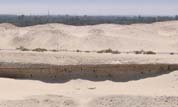 There
was surprisingly little canal construction or maintenance work happening, the
main exception being some dredging in the lake area. The three workmen
scratching away with pickaxes provided an amusing and incongruous picture.
Perhaps they were heinous criminals serving out a cruel and lonely punishment
for their crimes, an endless task. The pipes sticking out of the sand are
probably for dewatering. A curiosity to me was that some of the banks in the
dredged material along the canal were perforated with that looked like miniature
cliff dwellings. They may have been the nests of sandpipers though no birds were
in evidence.
There
was surprisingly little canal construction or maintenance work happening, the
main exception being some dredging in the lake area. The three workmen
scratching away with pickaxes provided an amusing and incongruous picture.
Perhaps they were heinous criminals serving out a cruel and lonely punishment
for their crimes, an endless task. The pipes sticking out of the sand are
probably for dewatering. A curiosity to me was that some of the banks in the
dredged material along the canal were perforated with that looked like miniature
cliff dwellings. They may have been the nests of sandpipers though no birds were
in evidence.
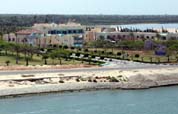
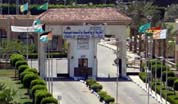
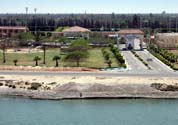
The Ismilia
Sporting Village was a modern wonder to behold as you can see by the pictures.
Note the children's" playground with its modernistic plastic slides, swings,
merry-go-round and sea-saws.
As part of the privilege of
using the Suez Canal a ship must allow a group of hawkers aboard for the trip.
They arrive in a small motorboat that is hoisted just up out of the water and
they set up their wares along the passage of A deck. None of us patronised them
although I think some of the Pilipino crew purchased a few gewgaws. If there had
been anything remotely interesting for my grandchildren I would have been
tempted but what a load of rubbish it was. They are provided with a free meal as
well. Apparently the earlier problem with the ships air conditioning was due to
loss of gas and I photographed the transfer of new cylinders of Freon delivered
out of Port Said just before we left the canal at the same time as the departure
of the hawkers.


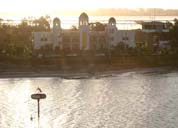
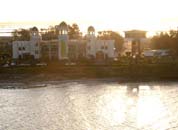
We left the canal in the early
evening via the middle channel. Here the land became closer and closer to sea
level and looked dark and damp and is apparently subject to flooding. The final
land marks on each side provided a complete contrast with the new container
terminal of East Port Said with its leading light beyond and on the west a most
beautiful mosque complex illuminated by the setting sun.
We anchored in the middle of the
night in the middle of nowhere as far as I could tell anyway from a quick walk
out on deck. It was hard to believe that were actually in the Mediterranean Sea.
I could see lights of other waiting boats but hardly a glimmer from the distant
shore. It was a very peaceful night anchored in the roadstead and I slept like a
babe.
Contact us at
cole@familycole.net Return to Home Page
 The
day started at a leisurely pace. A cool wind blew down on us as we lay at anchor
just behind another freighter. I could see part of the town beneath the
sandstone cliffs. I wandered up to the bridge for a yarn with the First Officer
and to take photos of the chart. Then down to B deck for scrambled eggs and
crispy bacon and a relaxed chat around the breakfast table with my fellow
passengers. Climbing back up the stairs we were preceded by portly Egyptian
pilot who was making laborious weather of it. He was aboard to guide us from the
anchorage to our place in the convoy queue and then through the Suez Canal. We
felt the shuddering of the anchor being hauled aboard at the same time as we
watched the neighbouring ship Hanjin stirring up yellow mud as it
manoeuvred in the shallow water behind us. Every day just one convoy passes
through the canal in each direction while other ships pass through in stages.
I'm not sure of the exact routine and I didn't want to bother the officers with
what they probably think are a whole lot of silly questions. The canal is not
used at night. The Captain did say that it costs something like one-hundred and
ninety-thousand dollars for a ship our size, the cost carefully calculated to
make it just a little more economical to use the canal that to go the long way
around the bottom of Africa. It's a nice little earner for Egypt no doubt.
The
day started at a leisurely pace. A cool wind blew down on us as we lay at anchor
just behind another freighter. I could see part of the town beneath the
sandstone cliffs. I wandered up to the bridge for a yarn with the First Officer
and to take photos of the chart. Then down to B deck for scrambled eggs and
crispy bacon and a relaxed chat around the breakfast table with my fellow
passengers. Climbing back up the stairs we were preceded by portly Egyptian
pilot who was making laborious weather of it. He was aboard to guide us from the
anchorage to our place in the convoy queue and then through the Suez Canal. We
felt the shuddering of the anchor being hauled aboard at the same time as we
watched the neighbouring ship Hanjin stirring up yellow mud as it
manoeuvred in the shallow water behind us. Every day just one convoy passes
through the canal in each direction while other ships pass through in stages.
I'm not sure of the exact routine and I didn't want to bother the officers with
what they probably think are a whole lot of silly questions. The canal is not
used at night. The Captain did say that it costs something like one-hundred and
ninety-thousand dollars for a ship our size, the cost carefully calculated to
make it just a little more economical to use the canal that to go the long way
around the bottom of Africa. It's a nice little earner for Egypt no doubt.



















